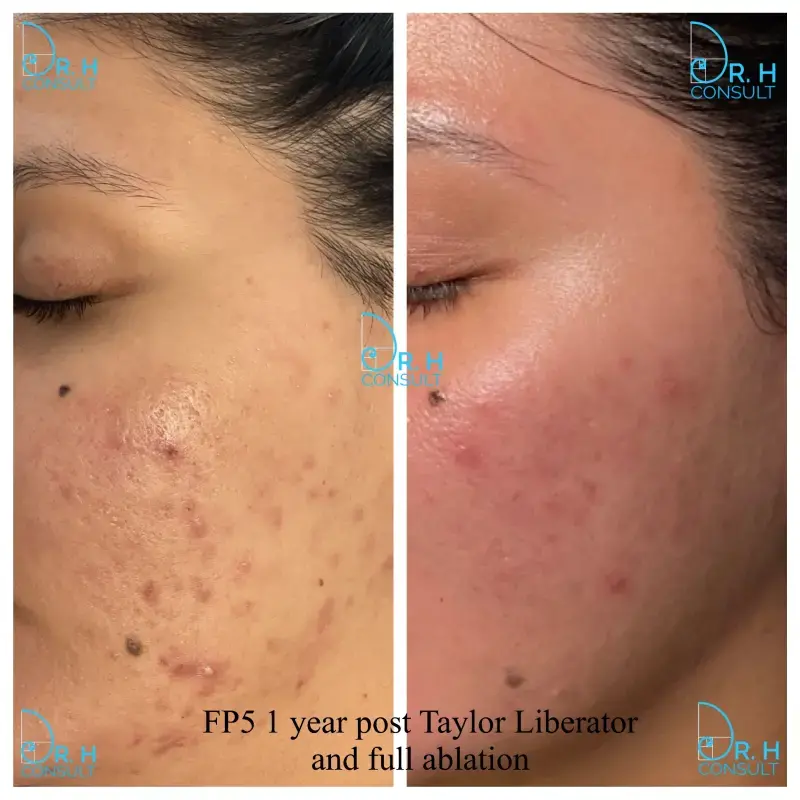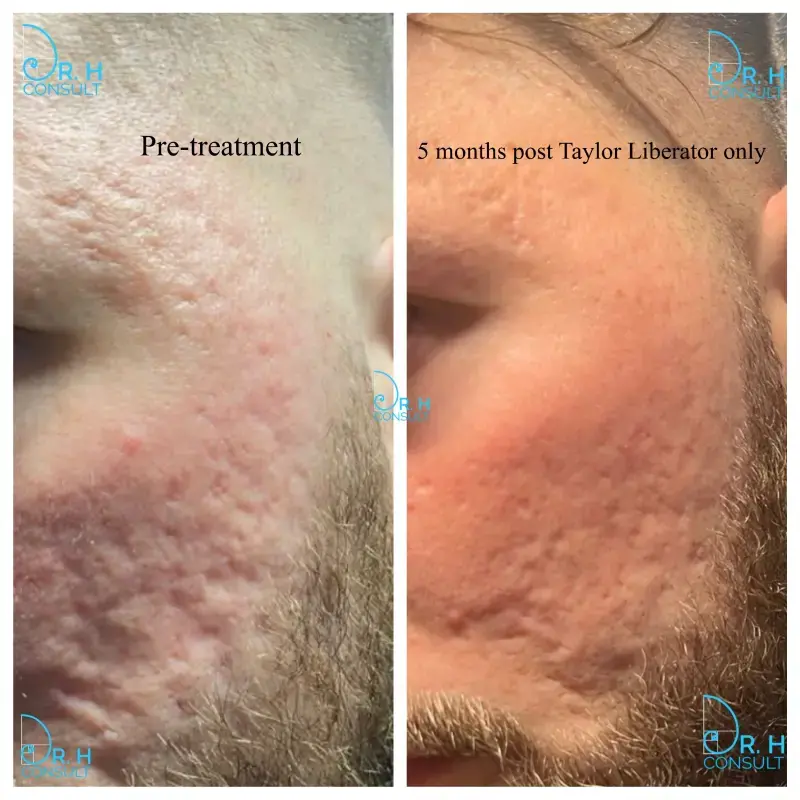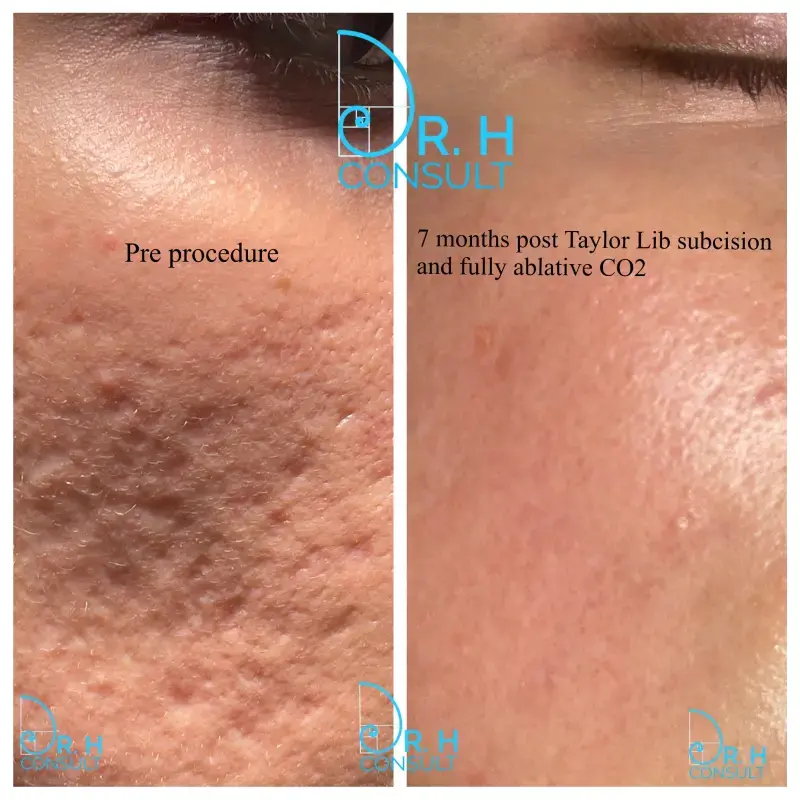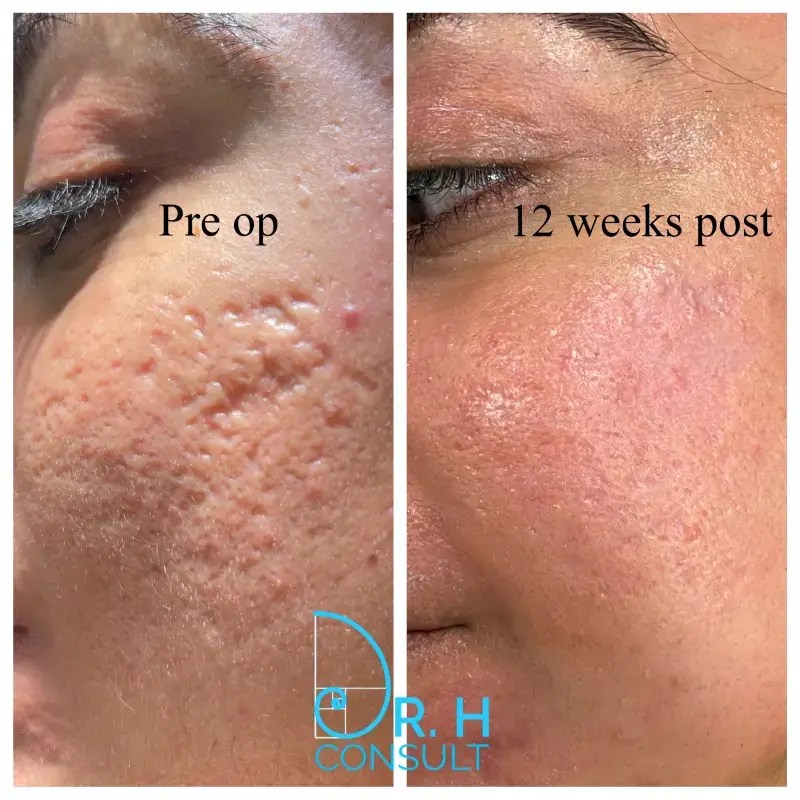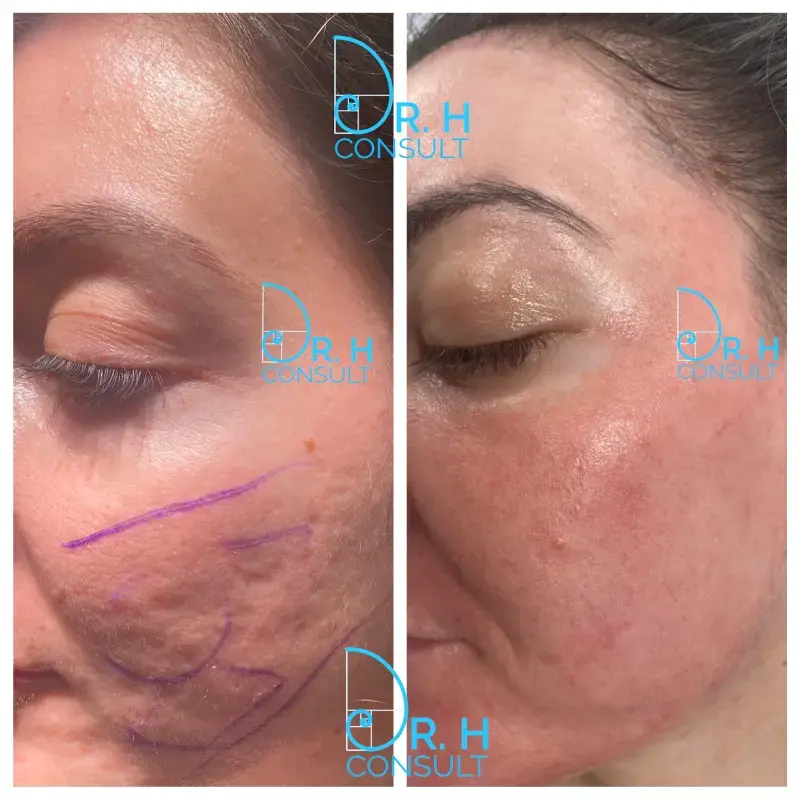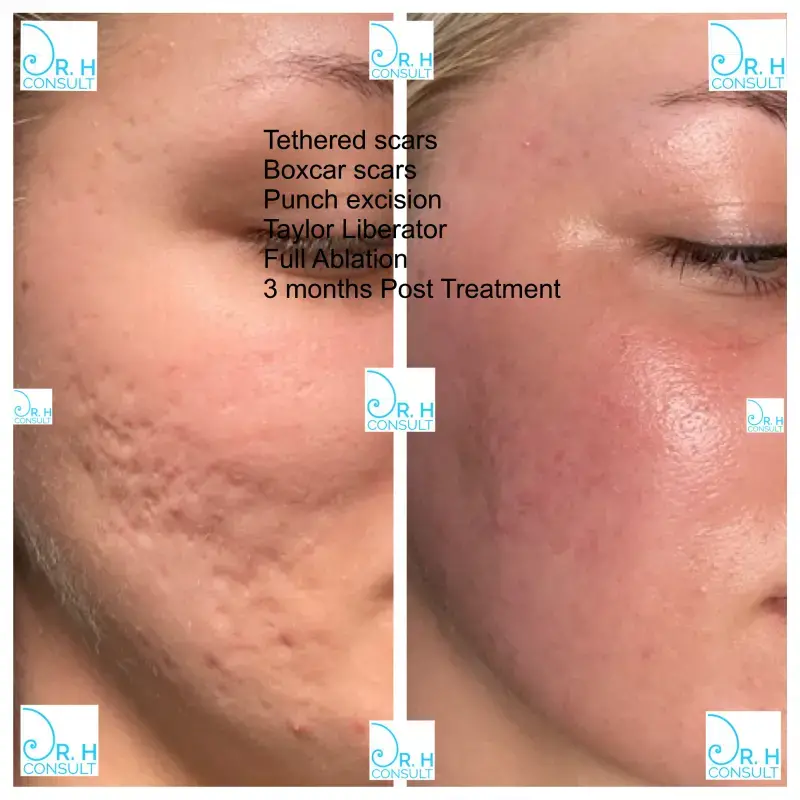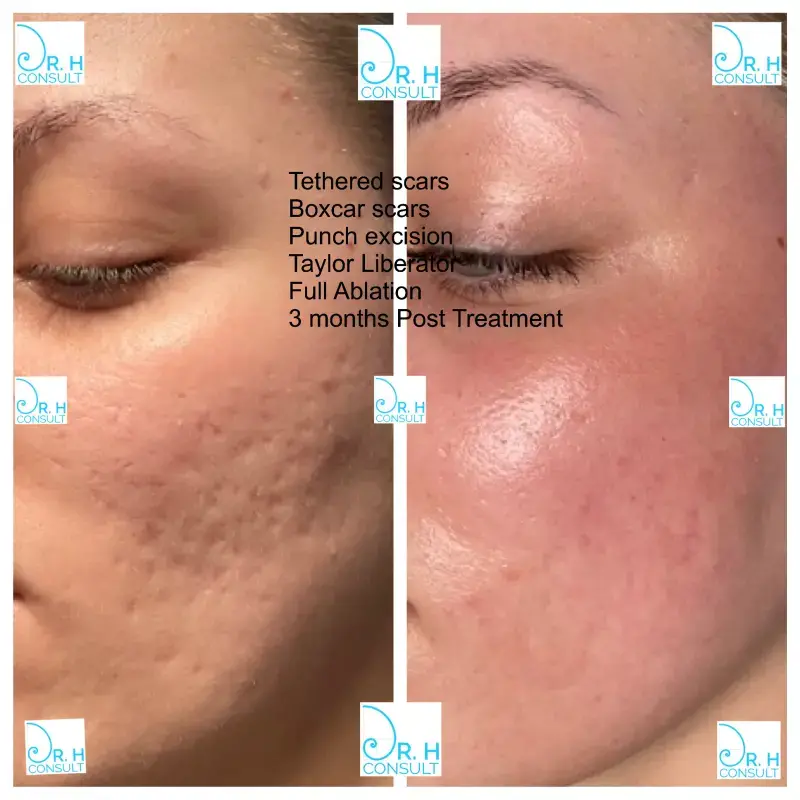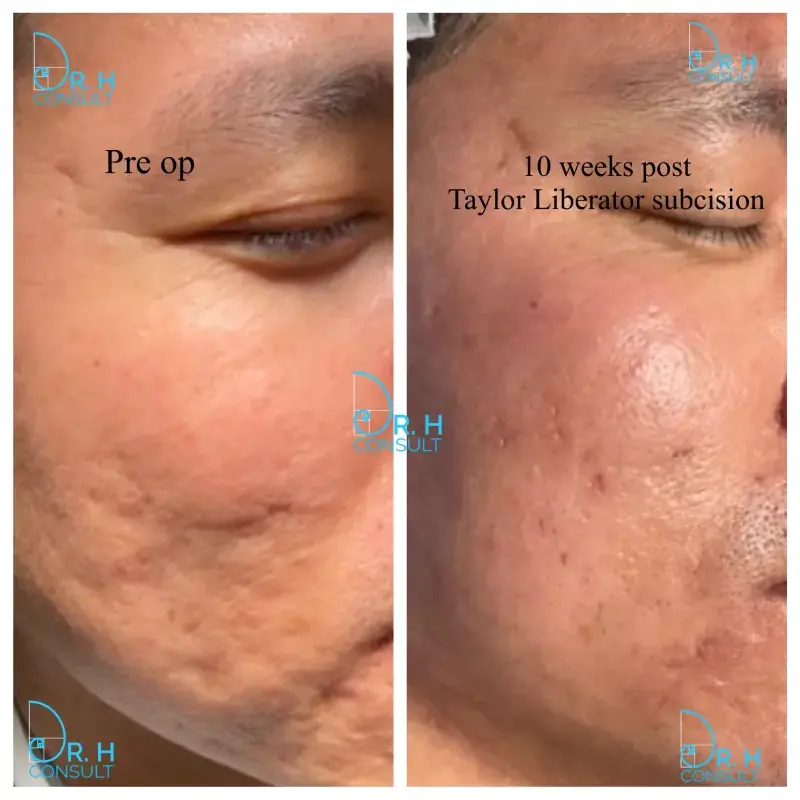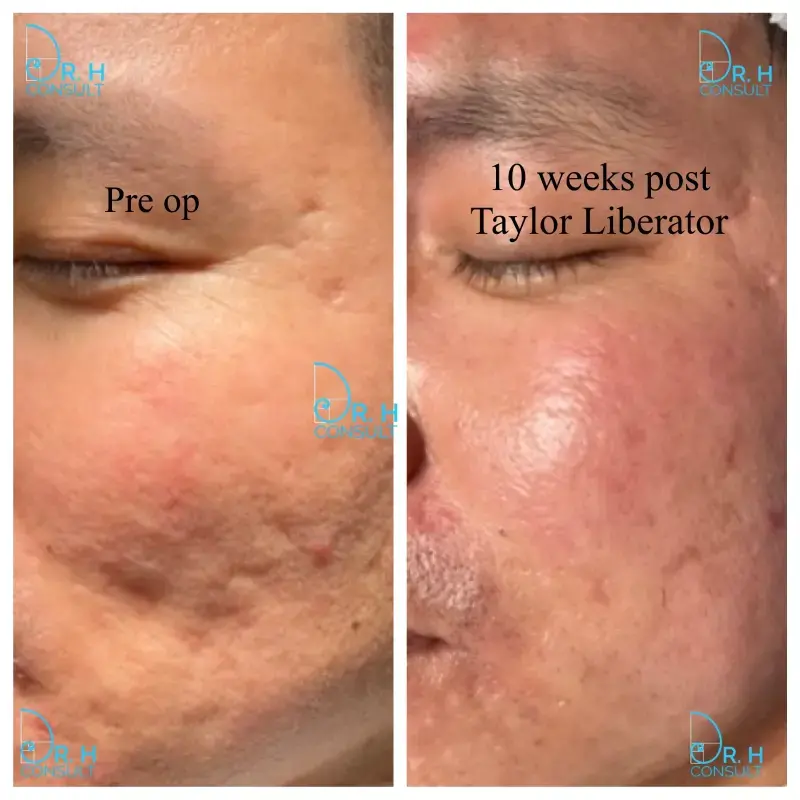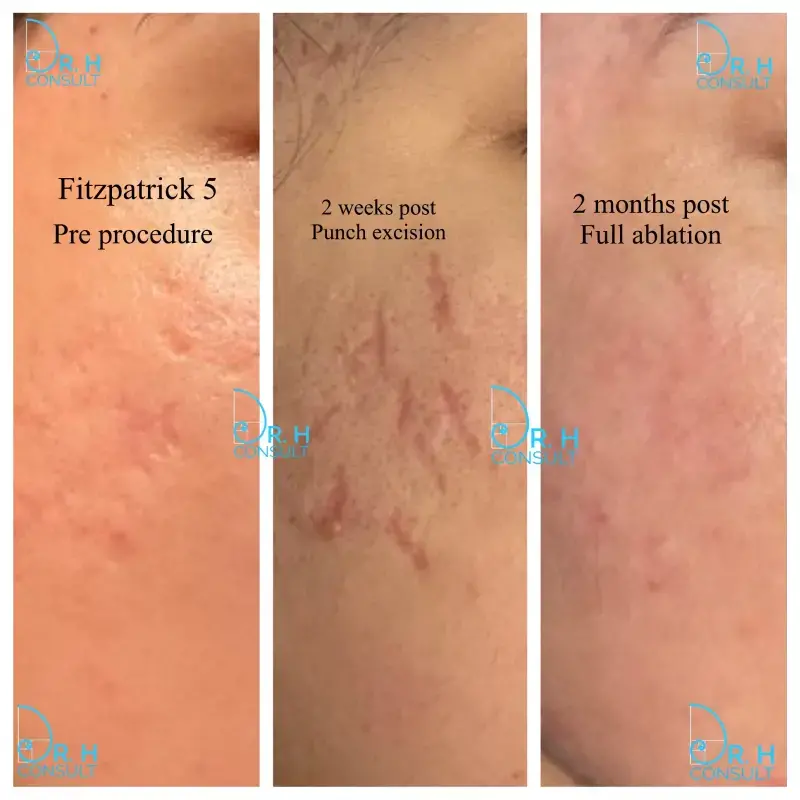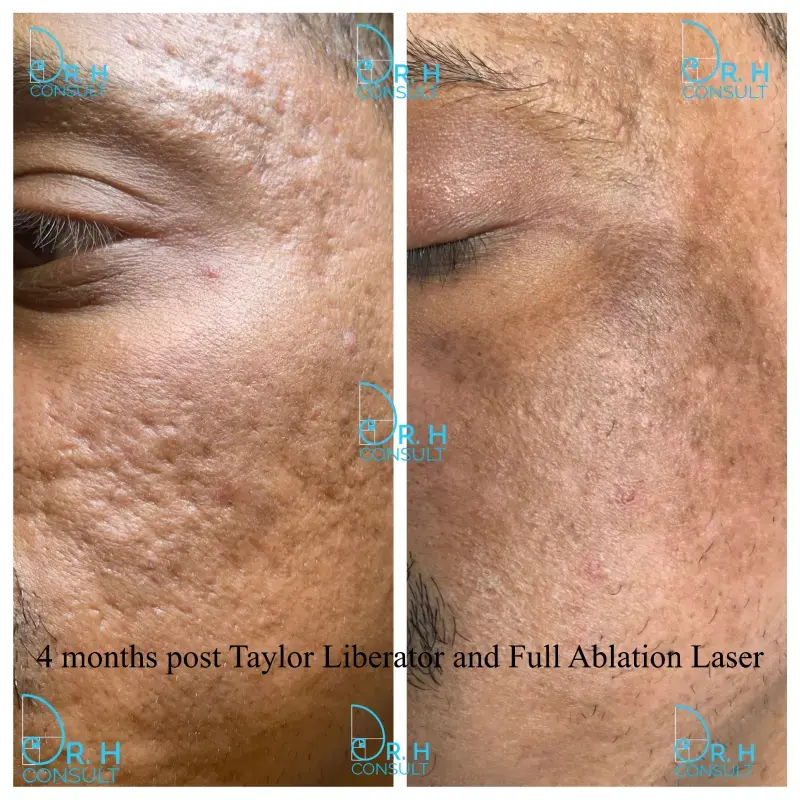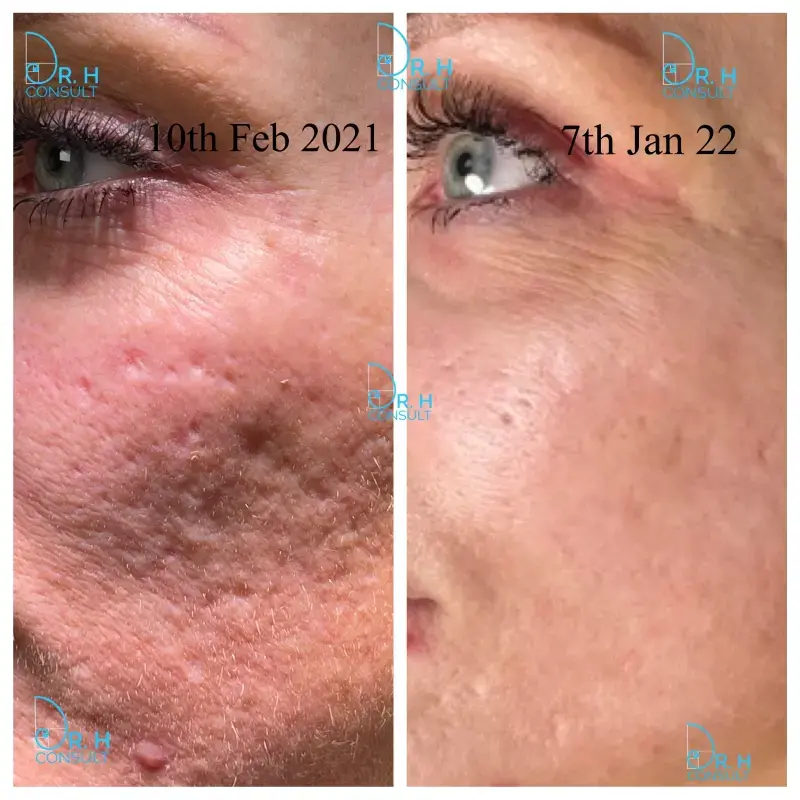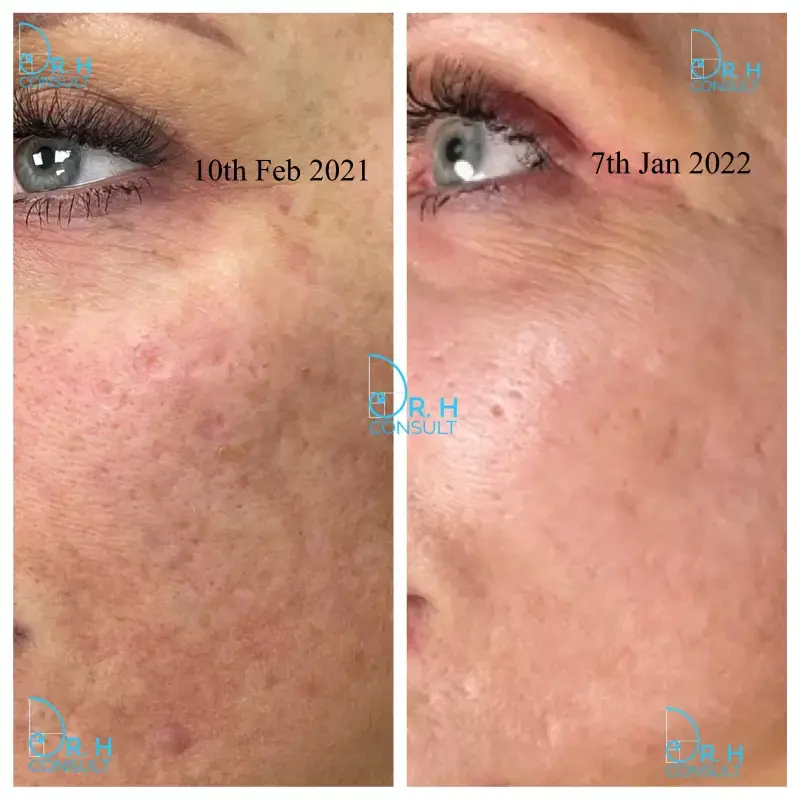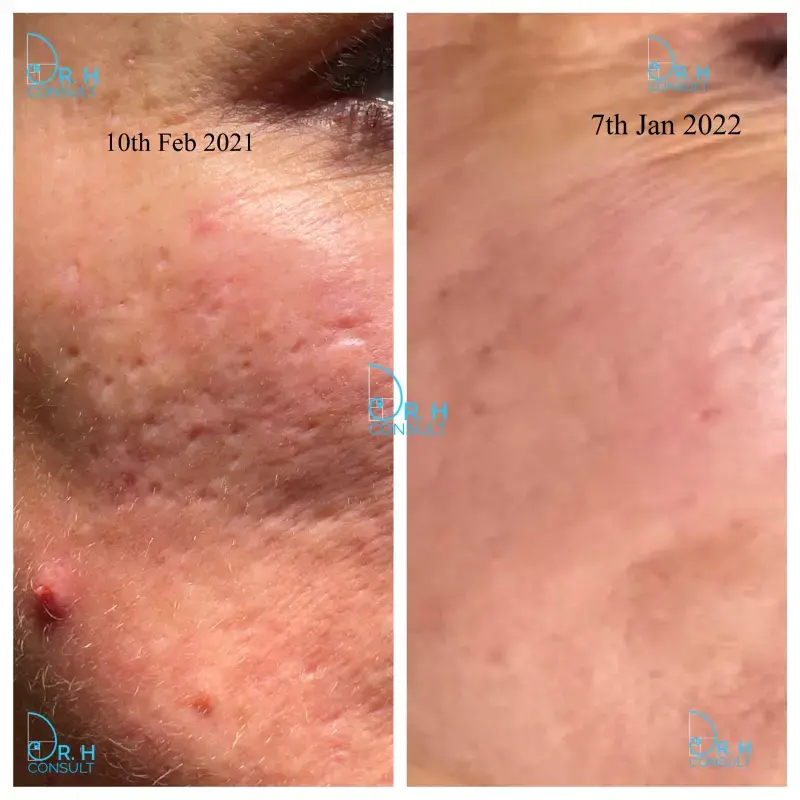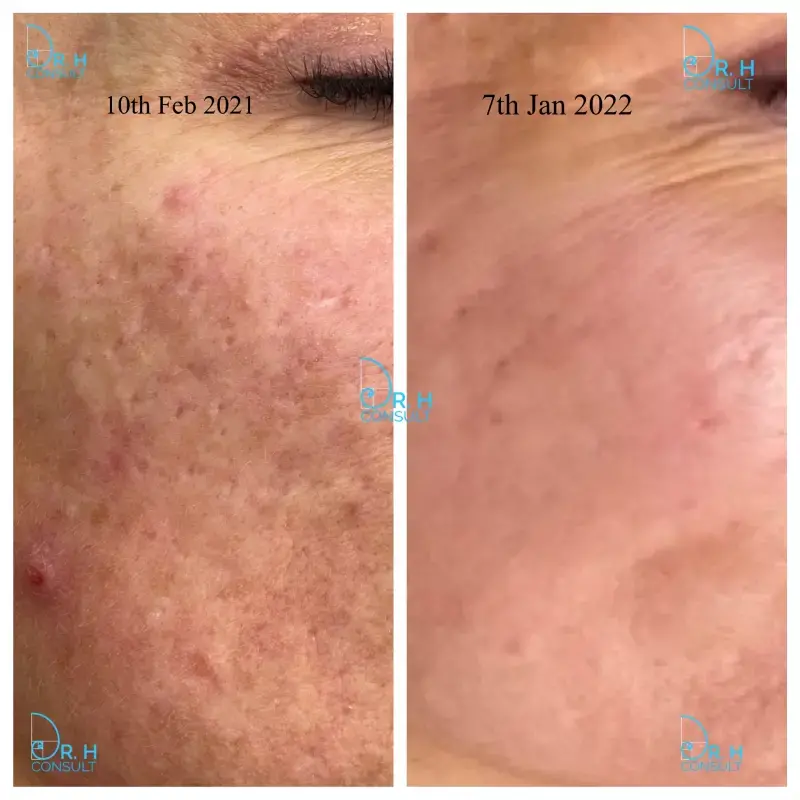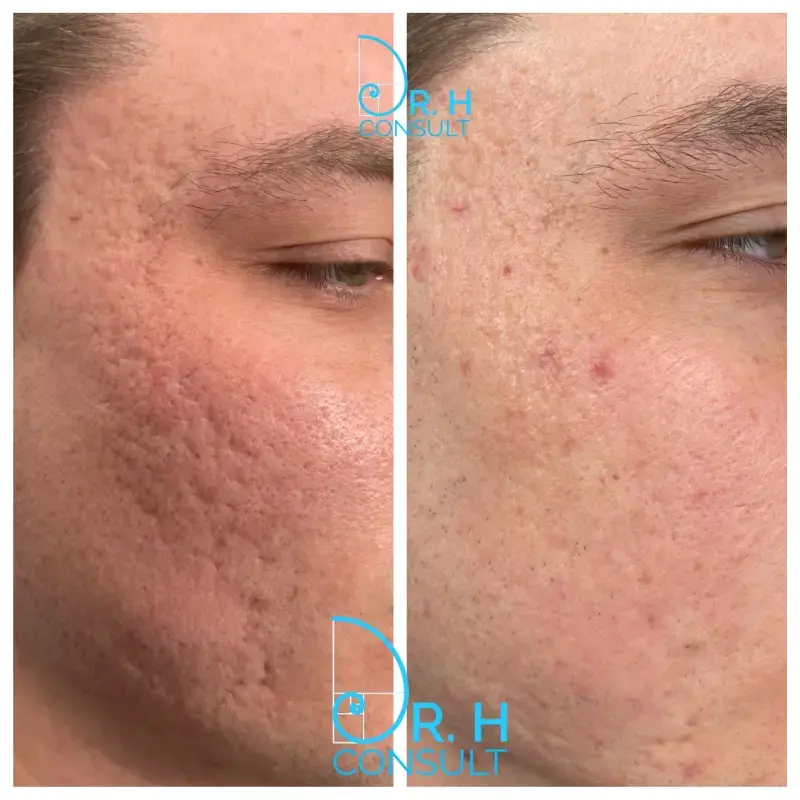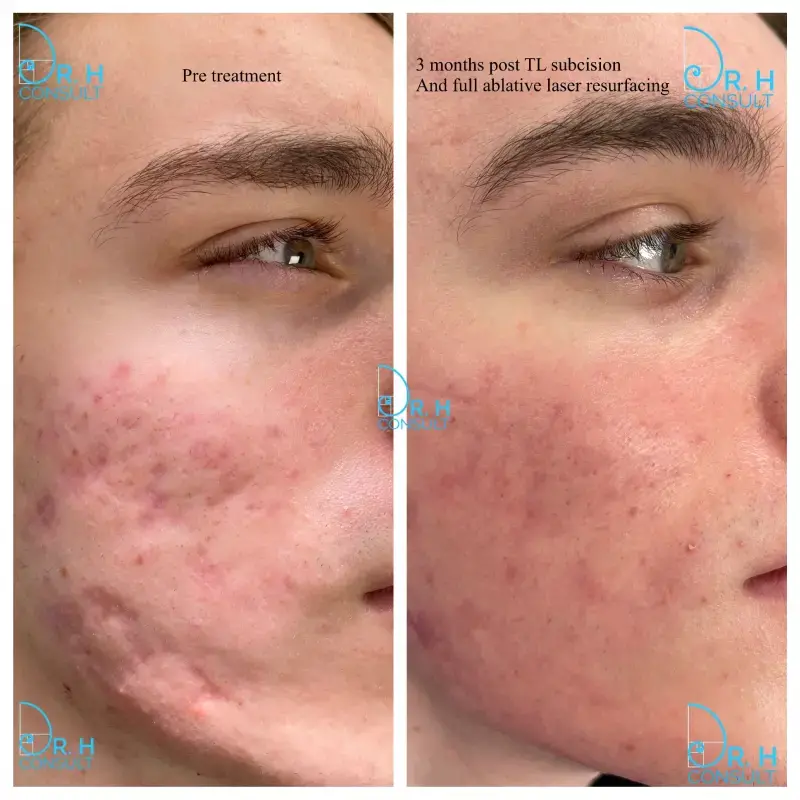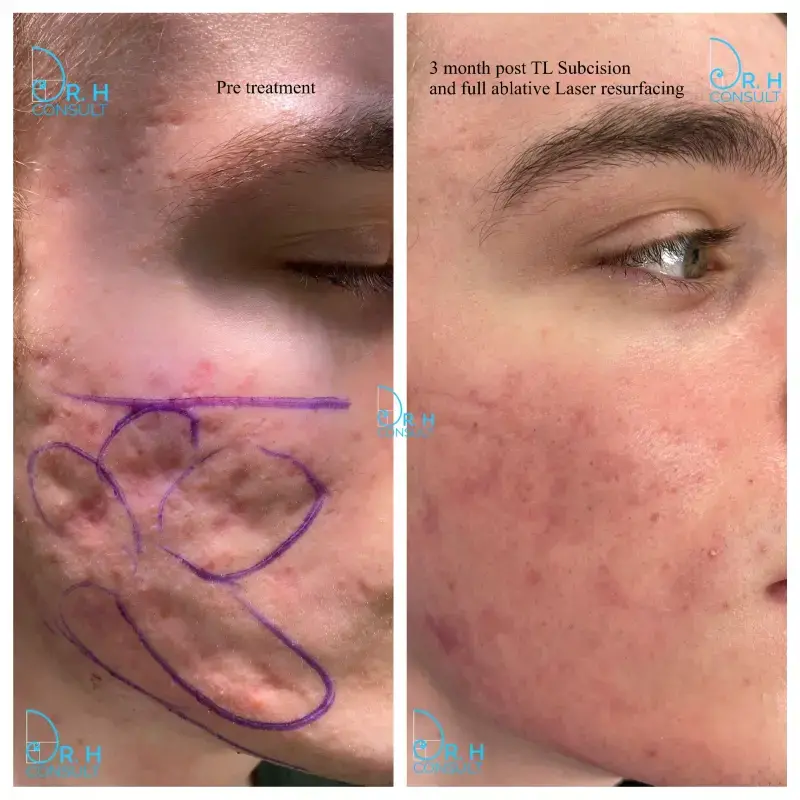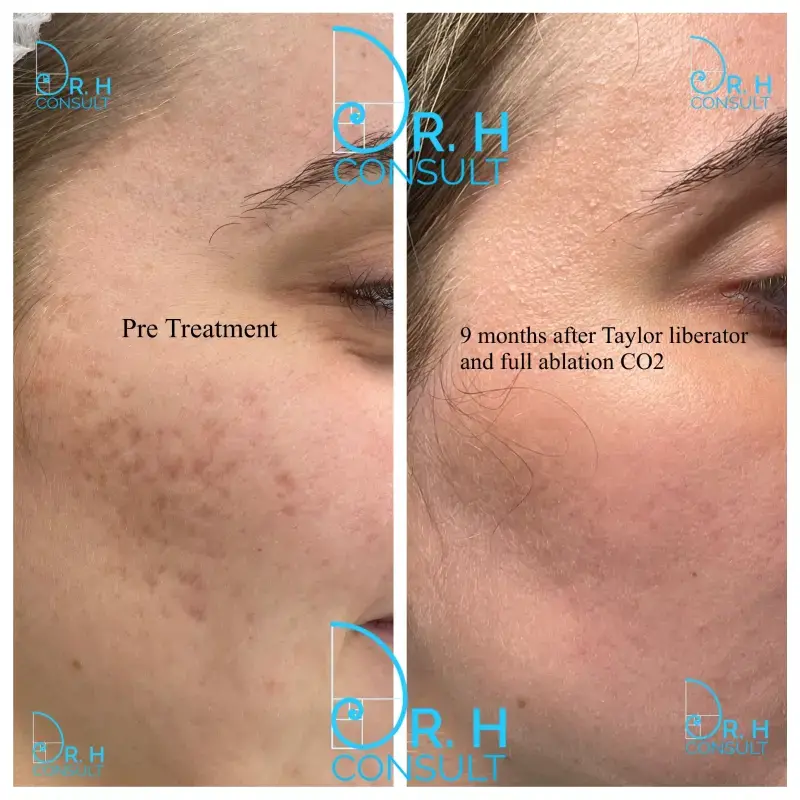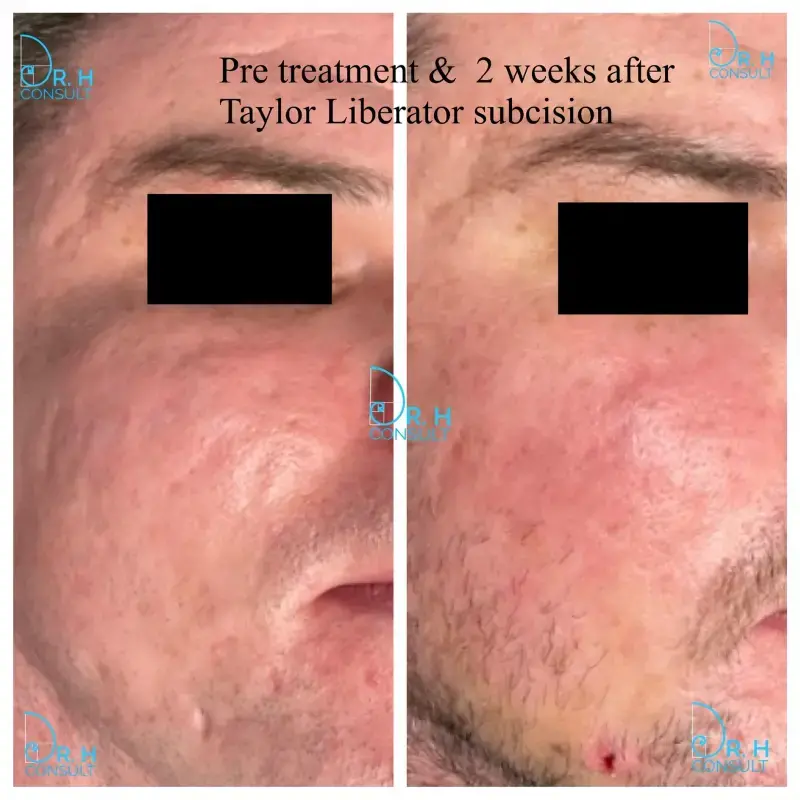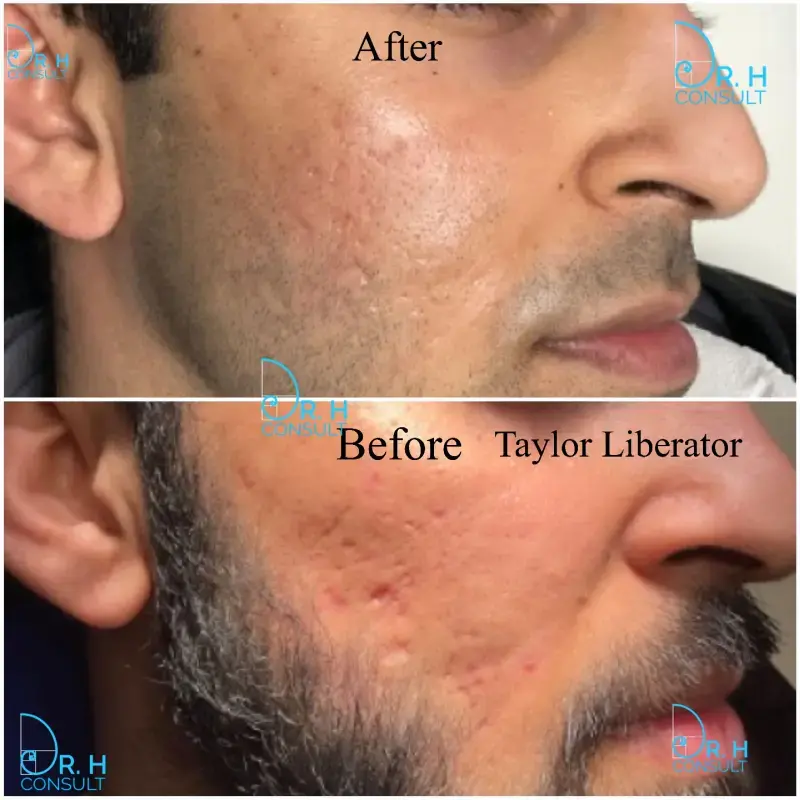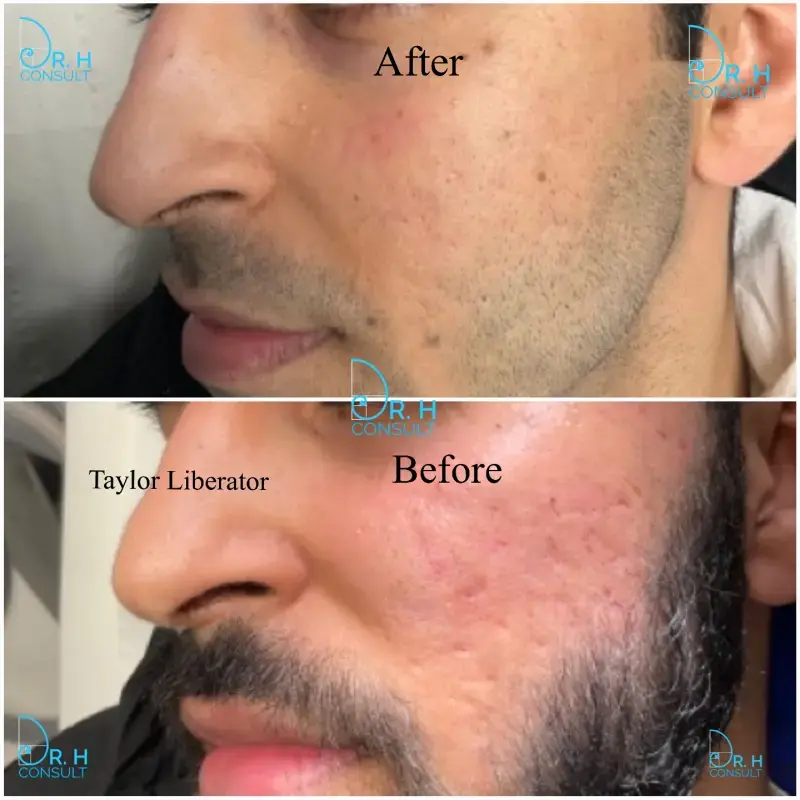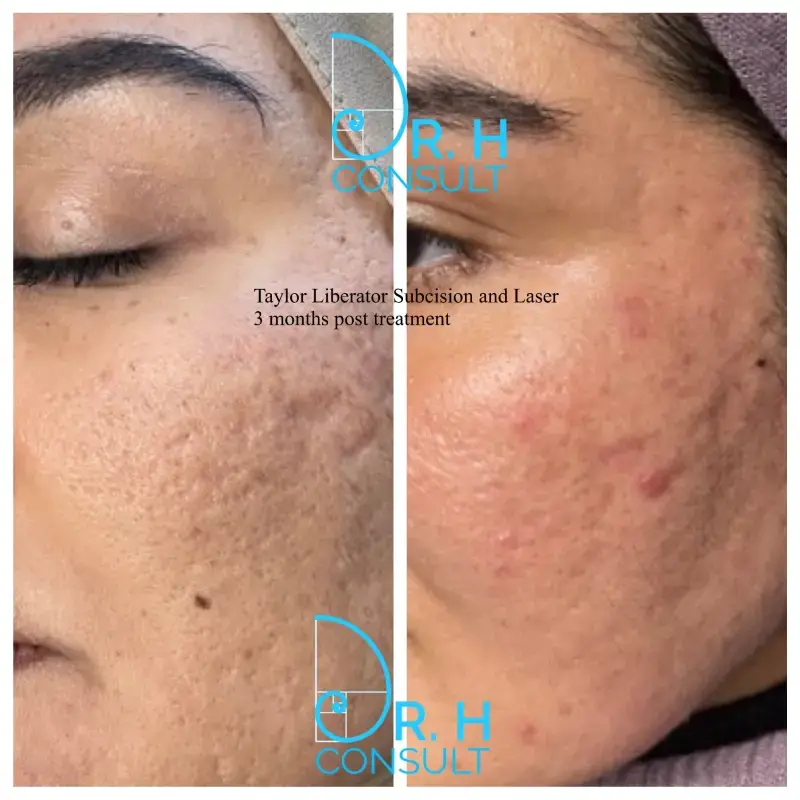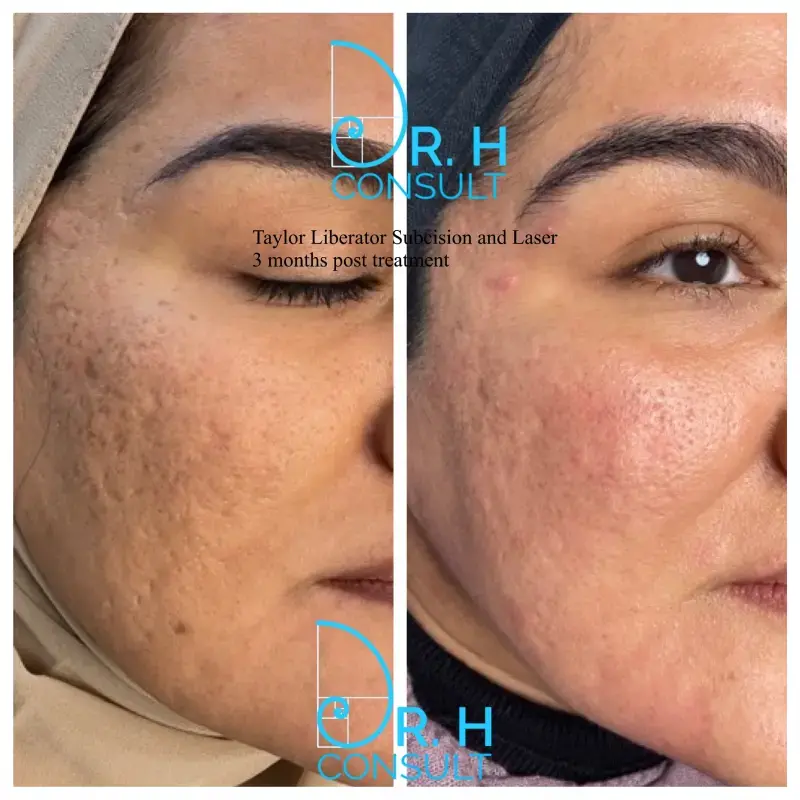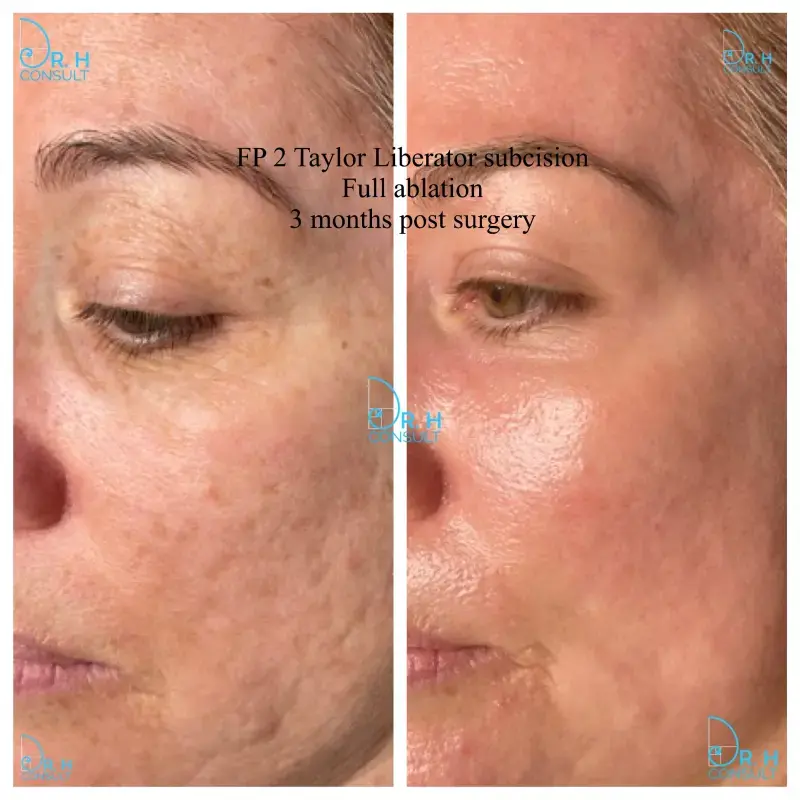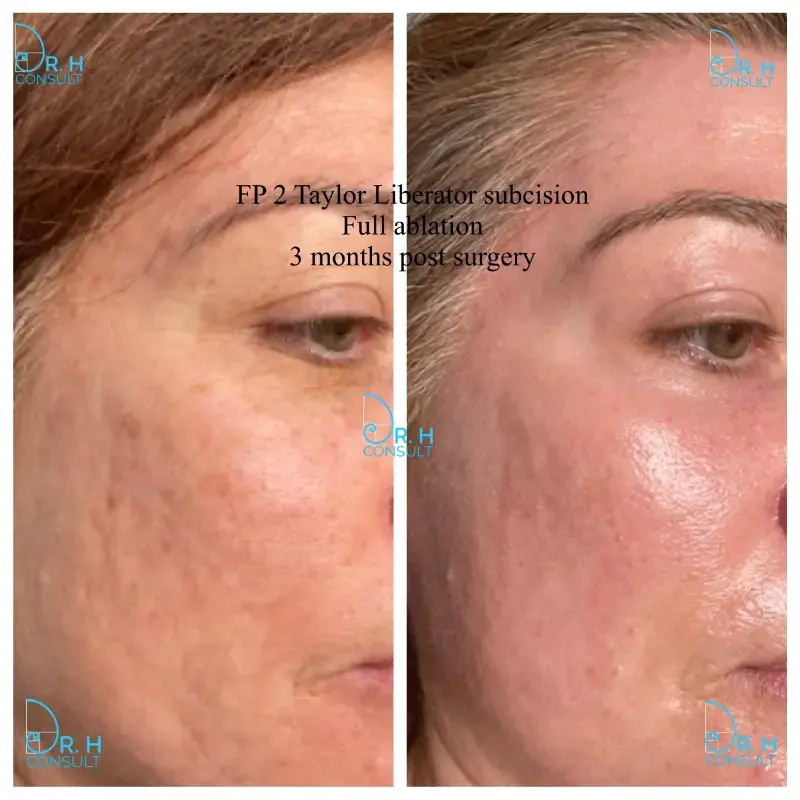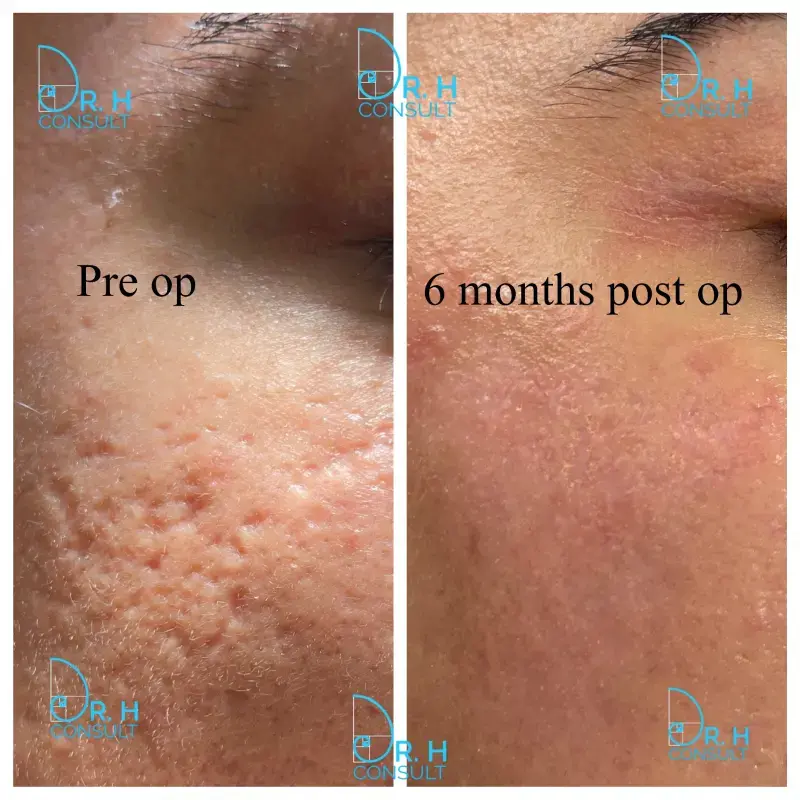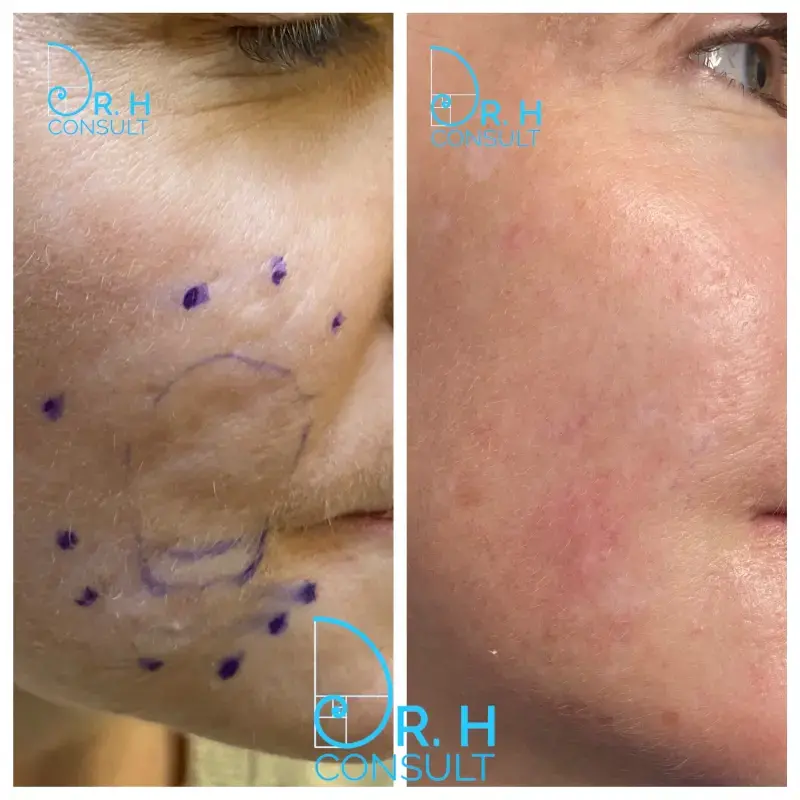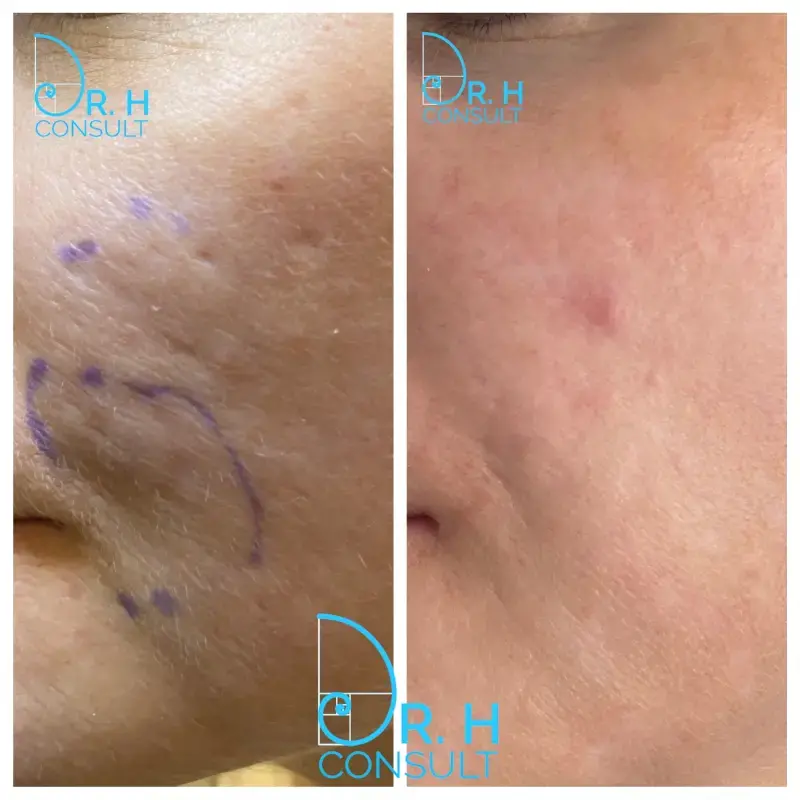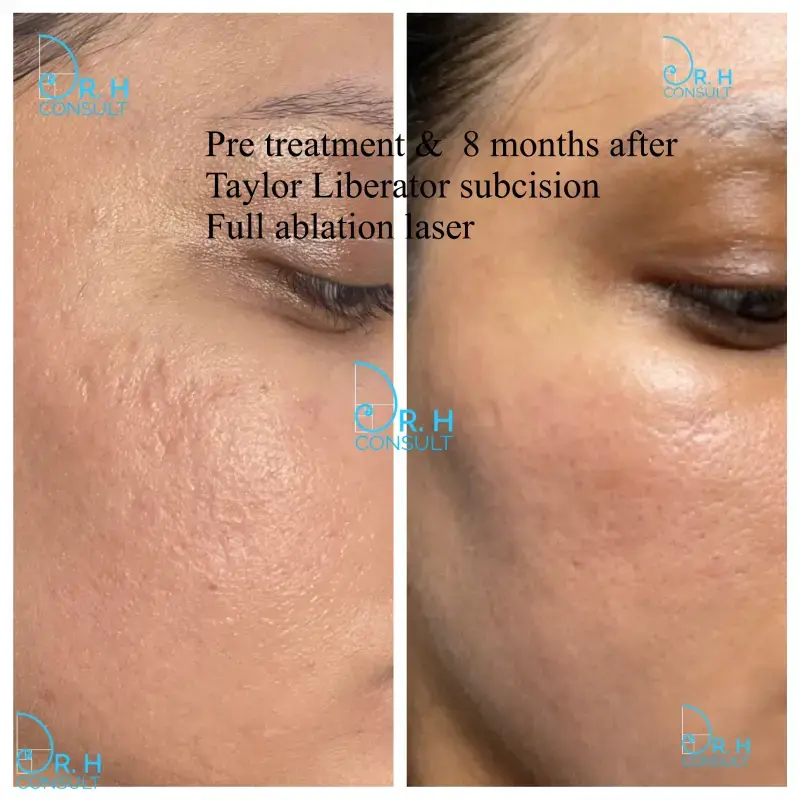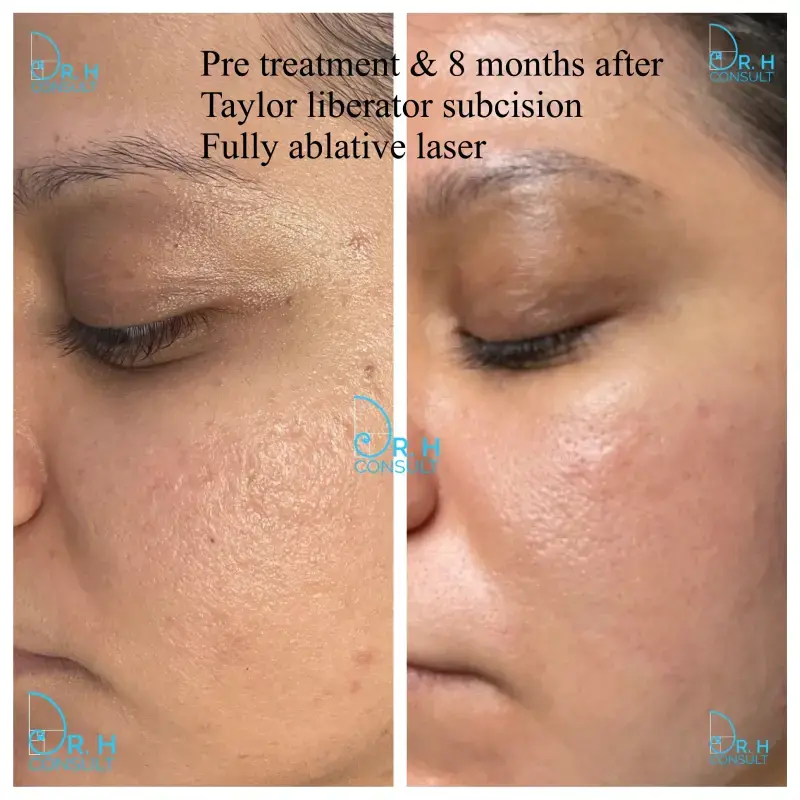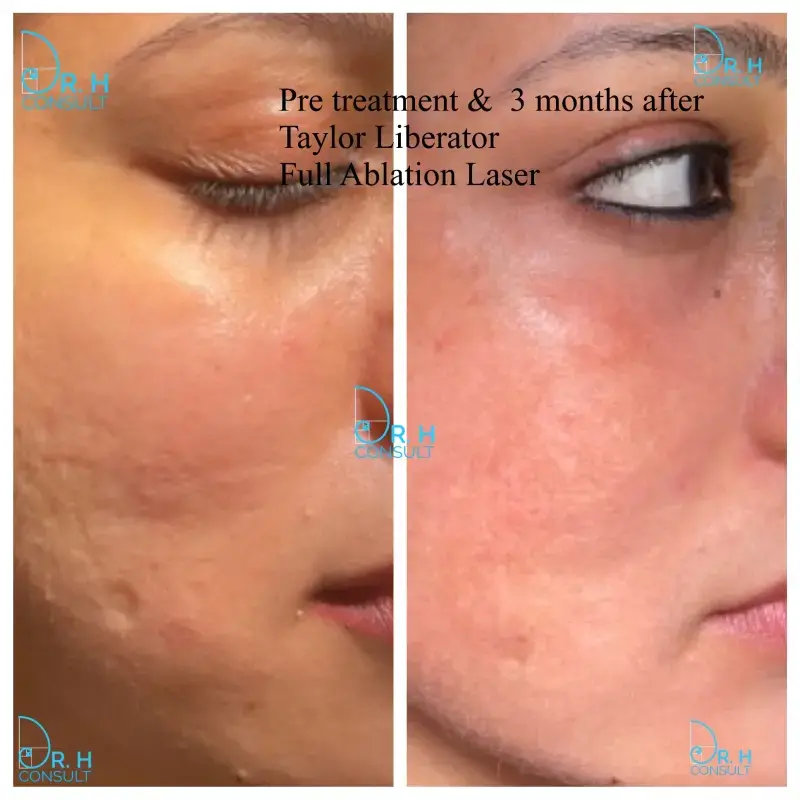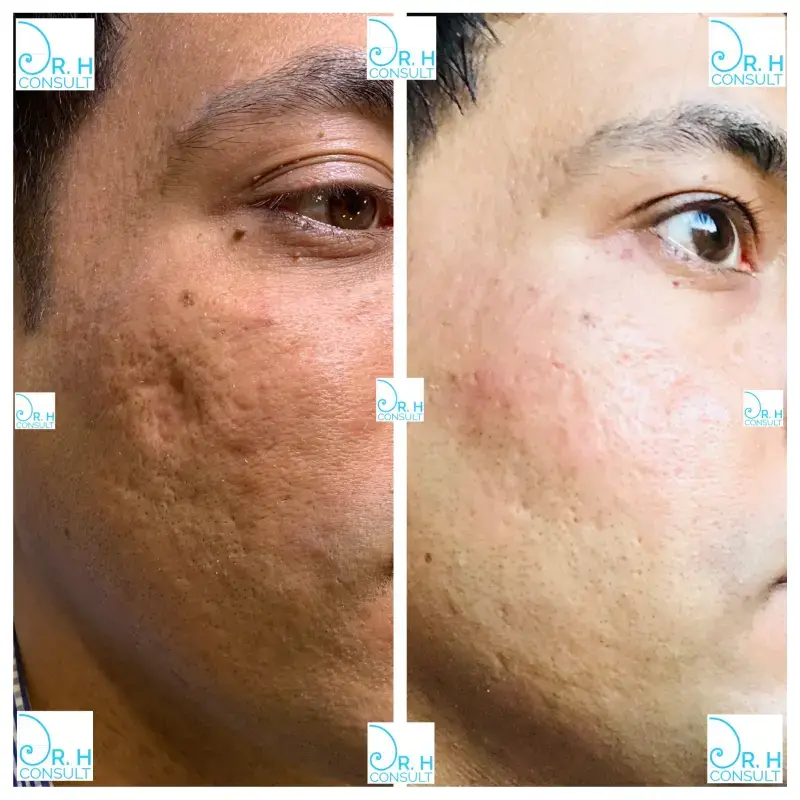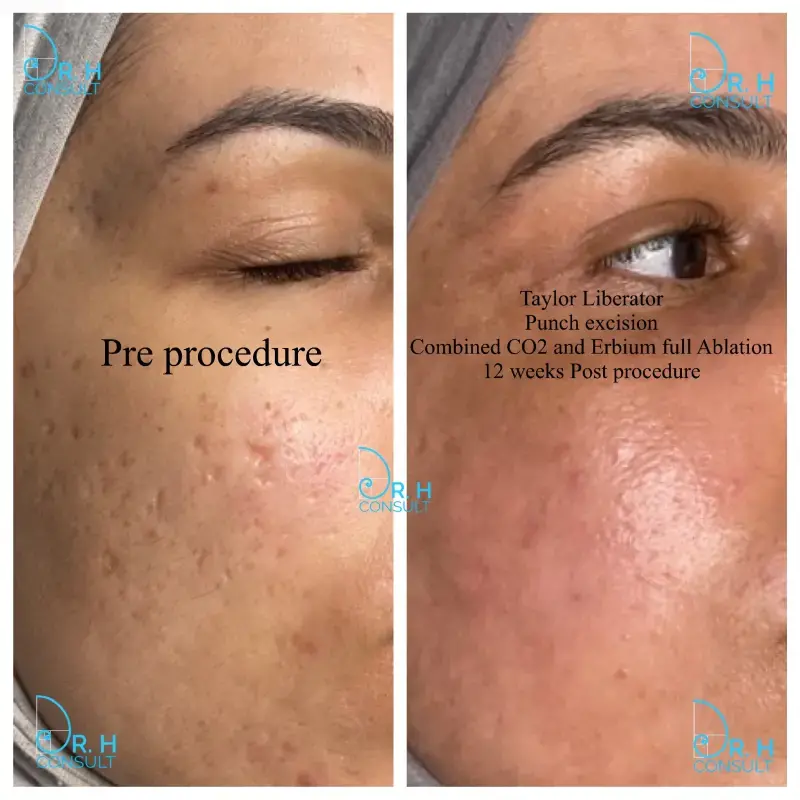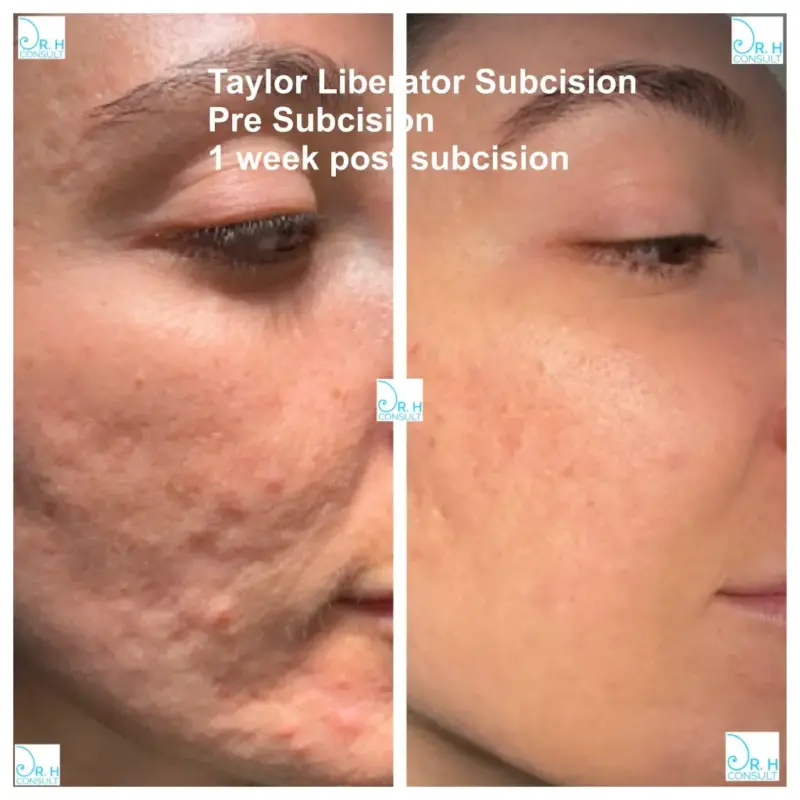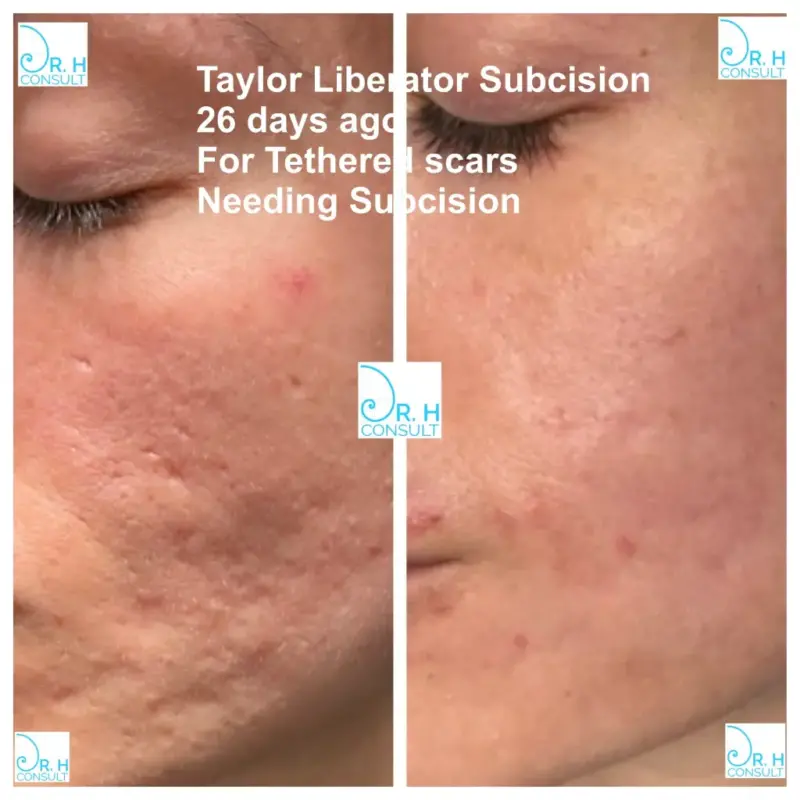Acne Scarring at DrHConsult
- Dr Hussein is recognised as an international authority in the management of acne scarring.
- The surgical management of acne scarring forms his primary specialist interest.
- It is essential to understand there are many other evidence-based techniques that offer lower risk and downtime. These lower risk methods are summarised here also. Dr Hussein specialises in the more aggressive surgical management of acne scarring. By electing for acne scar treatment with Dr Hussein you are essentially opting for essentially a much greater improvement in your scar. The methodologies that Dr Hussein uses are summarised in the surgical acne scarring management pathway that he has developed.
- As of 2023 Acne Scar Management accounts for over 60% of his workload. He therefore has extensice experience in surgical management of acne scarring. DrHConsult is a world leading acne scar management centre.
Comprehensive Surgical Management of Acne Scarring
The diagram below summarises the pathway that Dr Hussein uses in the management of acne scarring.
It is important to understand that all of these techniques including fully ablative laser surgery can be performed in ALL SKIN TYPES. Unfortunately many doctors are not aware of this and sometimes may unintentionally give inaccurate information to acne scar patients.
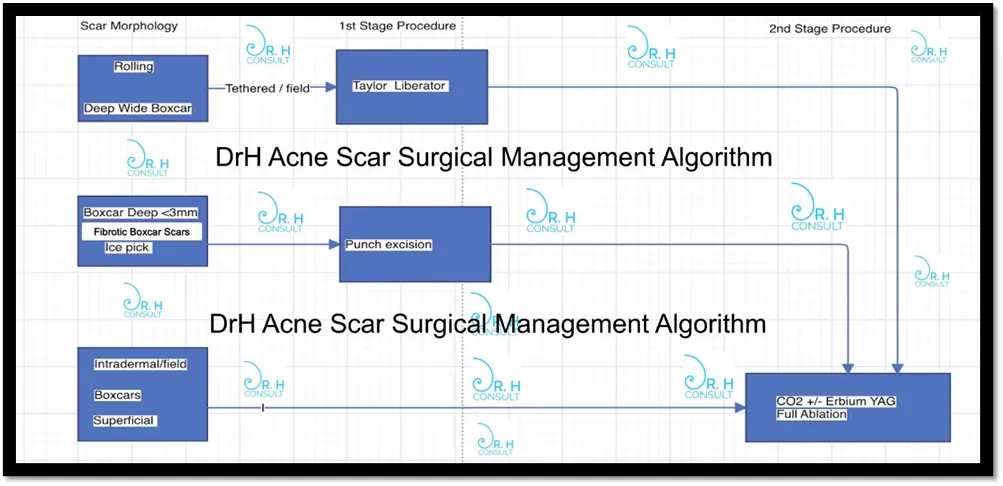
Extensive information regarding each of the procedures he performs can be accessed by clicking on the links below:
Acne scarring treatment is a form of reconstructive surgery
Acne is a disease of the skin. Acne scarring is a deformity in the skin architecture and anatomy that arises as a consequence of this disease. As such Dr Hussein regards treatment of acne scarring as a form of reconstructive surgery. It is not a cosmetic treatment.
Surgical management of acne scarring involves using techniques such as Taylor Liberator Subcision, Punch excision and Fully Ablative Laser surgery to help to physically remodel the scarred skin by giving it a more normal structure and contour.
Why do people see Dr Hussein for Acne Scar Management?
Unfortunately acne scarring often regarded by those in the medical community as a relatively minor cosmetic issue. Its management is not therefore taken seriously. It certainly isn’t managed in the NHS. As a result the medical/surgical experience in its management is sadly lacking. This is quite simply because dermatologists and plastic surgeons do not manage it as part of their routine hospital practice. In their private practice it only forms a minimal volume of the cases and hence appropriate experience in its management is not gained easily.
It is therefore often undermanaged by low risk, less invasive techniques such as:
- Microneedling
- Chemical peels
- fractional laser
- radiofrequency microneedling
- non-ablative laser
- blunt cannula subcision and fillers
Even though these techniques have a solid evidence base in medical literature the degree of improvement conferred by these techniques is relatively minor when compared to the comprehensive surgical approach used by Dr Hussein. It is important to understand that Dr Hussein is not advocating one methodology over the other. He specialises in more aggressive management techniques, The above techniques obviously carrier a lower risk and a lower downtime versus Dr Hussein’s pathway but they also confer a much lower degree of improvement. Due to Dr Hussein’s extensive case load and experience in acne scar management he is able to mitigate the risks associated with more aggressive management.
By specialising in only the acne scar management techniques in the pathway above Dr Hussein maintains a high caseload in all three core surgical management areas (Taylor Liberator Subcision, Punch Excision and Fully Ablative Resurfacing.
It is important to understand that although he understands and can perform other modalities of acne scar management, he specifically chooses not to. This is because this would result reduction of case volume in each of the three pathway techniques. Reduced case volume leads to a reduction in experience surgical skills in these areas.
If by any chance you have not realised this by researching this website and require alternative techniques Dr Hussein is happy to advise and refer you appropriately during your consultation. Dr Hussein is certainly not insisting that patients undergo this type of aggressive management. It is often however the case that by the time that most acne scar patients see him they have already undergone a significant amount of lower risk procedures but are still not content with the result. This combined with the psychological impact of acne scarring causes his patients to seek out his more comprehensive approach.
Summary of other acne scar treatment options available
Microneedling
This is by far the most popular treatment used to treat acne scars. It is effective but only mildly so. Treatments are multiple in nature and do go some way to produce new collagen and remodel collagen in sunken acne scars. One of the reasons why this treatment is popular is because the recovery time is quick. Usually, the patient can go to work the next day with only some mild redness as a consequence of the treatment. The redness usually will last a maximum of two days.
Even though tangible benefits are only very mild in each treatment the trade-off is quick recovery. it is a good way of improving one’s acne scarring without having to take time off work. There are multiple devices. Dermapen is an electronic needle stamping device in which needles can be repeatedly stamped to a controlled depth (eg 1.5mm) at a speed of 100 times per second. Less state-of-the-art in the world of microneedling are simple roller devices that needle the skin using a rolling motion. Often local anaesthetic cream is used prior to the procedure as it is uncomfortable despite a quick recovery.
Chemical Peels
This is also a proven technique in the treatment of acne scars. A caustic agent such as Trichloracetic Acid (TCA) is applied to the skin and causes the outer layers of skin to be removed by a process of controlled chemical burn. This helps acne scarring in two ways. There is an element of surface remodelling through regrowth of a new superficial dermal and epidermal layer. The inflammatory process causes an increase in the production of new collagen as part of the healing process. By the nature of chemical peels, this remodelling and collagen formation is limited to the upper layers of the skin.
Improvement is mild but if a good medically qualified provider is used a typical TCA 25%/Jessners combination peel or TCA 35% peel can achieve a better result equivalent to multiple microneedling treatments.
The downside is that recovery time is in the region of 7-9 days. As a result, more technically advanced treatment providers are offering fractional laser resurfacing as the benefits are greater for a similar amount of downtime. Therefore chemical peels although effective are seen as somewhat old-fashioned.
Radiofrequency Microneedling
This is a type of microneedling that combines radiofrequency energy via the needles. The idea behind this concept is that with the thermal energy created by radiofrequency greater collagen stimulation is created than needling alone. There is limited evidence to support this claim. At present results appear to be more device, technique and operator dependent. Fractional laser treatment with CO2 laser is a more powerful modality with a much greater evidence base. It is not unreasonable to expect a greater improvement than with microneedling alone.
However there is greater downtime and discomfort with radiofrequency microneedling when compared to normal microneedling. Risks of thermal injury and burns are also correspondingly increased. The likelihood of track marks and post inflammatory hyperpigmentation is also greater versus normal microneedling. Radiofrequency microneedling is an increasingly popular and relatively low risk technique.
To achieve good results it must like any other treatment be used for the appropriate scar type. Multiple treatments are still unlikely to result in any greater than 20% improvement in intradermal acne scars.
Fractional Ablative Laser Resurfacing (fractional CO2 or Erbium YAG laser)
Fractional CO2 is an excellent way of improving acne scars. It is by far the most effective method in this summary of alternative treatments. Fractional lasers (as their name suggests) only treat a fraction of the skin surface. This is why the skin remodelling effect acne scar is far less when compared to fully ablative resurfacing. The main advantage of fractional ablation over full ablation is the quicker recovery and lower risk of complications such as infection and scarring.
Fractional ablative laser is operator and device dependent in results. It can typically give a benefit of up to 20% improvement in intradermal scarring versus around 70% improvement with fully ablative laser resurfacing. The degree of density and depth of fractional ablation is highly variable dependent on the skill and experience of the operator and the type of device used. If greater depth and density are used the result is a greater improvement however the downtime and risk profile of fractional ablative laser begins to approach that of fully ablative laser.
Fractional Non-Ablative Laser
Non ablative lasers achieve improvement in acne scars by causing burn columns in the skin. These precisely controlled columns of thermally destroyed skin tissue trigger a necrosis, inflammation and remodelling of the skin. This process will certainly help with acne scars. Recovery is much faster when compared with fractional ablative lasers, The risk profile is also lower. Unfortunately despite multiple treatments with associated downtime improvement in acne scarring is mild and often will total no greater than 15-20% despite multiple treatments. As a result Dr Hussein feels the Cost-Benefit-Risk-Downtime makes non ablative laser an inferior and less efficient choice in the management of acne scarring.
Hybrid Lasers (Combining fractional ablative and fractional non ablative lasers in the same device)
This newer class of laser was designed to allow for greater improvement in acne scarring by combining more aggressive fractional ablative laser with less aggressive fractional nonablative laser simultaneously. An excellent idea but much more appropriate when treating fine lines, wrinkeles, sun damage and textural issues. Unfortunately the reality is that these devices show minimal improvement over and above non ablative lasers unless they are predominantly used in the fractional ablative mode.
Subcision (blunt cannula and nokor needle techniques) and TCA CROSS
DrH covers comparison of these methodologies of scar treatments in the relevant sections of this website.
Control of Active Acne prior to Acne Scar Management
It is essential that prior to opting for acne scar management with Dr Hussein any active acne should be treated. There is no logic managing acne scarring in the presence of acne scarring. If active acne is present it will only be exacerbated by any methods used to treat acne scarring. This is because all methods of acne scar treatment involve inducing an inflammatory reaction within the skin. If there is already active acne this will only flare up in the presence of any acne scar treatment. Dr Hussein will therefore request that prior to treatment of scarring a more aggressive and longterm management solution to acne should be adopted. This will usually involve use of medications such as spironolactone or Roaccutane.
How does acne scarring occur?
Scarring can develop following acne, especially where nodules and cysts are a part of the disease. The inflammatory process in acne causes damage to the collagen scaffold of the skin resulting in pitted acne scars (atrophic scars). Very rarely in about 5% of cases acne results in overgrown raised scars (hypertrophic scars).
What will the treatment for acne scarring feel like?
For aggressive resurfacing with CO2 or Erbium YAG laser Dr Hussein uses a combination of nerve blocks, tumescent anaesthesia and sedation coupled with a topical anaesthetic prep. Basically everything short of putting you to sleep. Most areas of the face become completely numb but some areas on the cheek and nose tip may have a little bit of breakthrough pain. The advantage of doing fully ablative treatment under this type of anaesthetic is that you can go home (accompanied and NOT driving yourself) 30 mins after treatment. Putting you to sleep for this treatment which used to be the case doubles the cost as anaesthetist fees and overnight stay in a private hospital have to be factored in.After the laser procedure you will feel a sunburn sensation but this will completely settle after 24 hours. The main inconvenience for the first 3-4 days is ooze and swelling. Ibuprofen in the first 24hrs helps settle the burning sensation. By day 4 the oozing will have settled. What now follows is a shedding of the dead skin layers and this can be seen as fresh pink skin appearing. Sometimes people get itchy at this stage. This can be helped by an antihistamine and a special cream that Dr Hussein issues at the procedure. Dr Hussein will instruct on the use of the cream. By day 8 most of the dead skin has come away. You will now look red/pink. This redness will persist but slowly reduce over the next 6-8 weeks. Sometimes Dr Hussein can speed the resolving of the redness with KTP laser. Make-up and foundation can be commenced cautiously on Day 10 after treatment. Foundation and SPF or a BB cream disguise redness nicely. Dr Hussein can advise on appropriate skincare after treatment.
How long until my acne scars disappear?
During your initial consultation we will determine the exact type of scarring. Any underlying acne must be treated and settled before treatment. If you have been put on capsules for severe acne then you will need to wait 6 months after you have completed treatment to have laser.In general acne scars will not disappear. Appearance will improve by 50-70% following fully ablative combined laser resurfacing. Images to show the degree of improvement are available in the gallery. In general, this full improvement can be observed at roughly 4 months after treatment.



